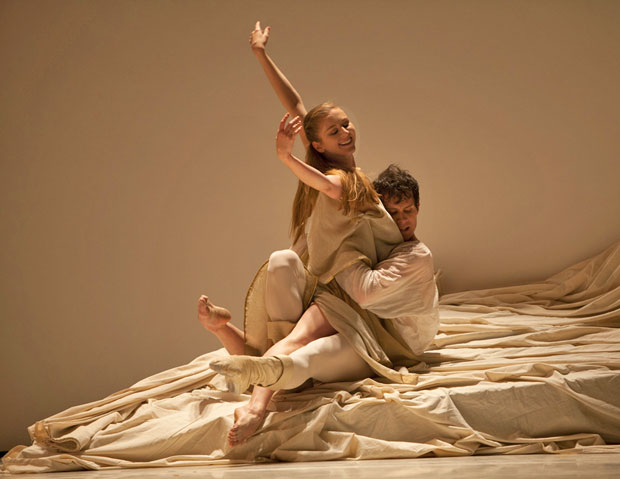
© Angela Sterling. (Click image for larger version)
This week, the Seattle-based Pacific Northwest Ballet will perform in New York (Feb. 13-16), its first full-company visit since 1996. Even the orchestra is coming along – important, since they’ll be performing Prokofiev’s Romeo and Juliet. It’s a big moment for the company, which seems to be thriving under the leadership of Peter Boal, a former New York City Ballet star. Several faces will be familiar to New York audiences from periodic appearances at Fall For Dance, Works and Process at the Guggenheim, and smaller engagements at the Joyce. For some of the dancers, like Carla Körbes, Seth Orza, and his wife Sarah Ricard Orza, the connection to New York runs deep. All three were students at the School of American Ballet at the same time and danced together (and with Boal) at New York City Ballet. After Boal retired in 2005 and was invited to lead PNB, they followed him to Seattle. Seth and Carla went on to become principals and dance a wide repertory, from Giselle and Apollo to works by William Forsythe and Alexei Ratmansky. Körbes, who is from Porto Alegre in southern Brazil, first danced the role of Terpsichore in Apollo at the age of fourteen in a school performance. Her partner was none other than Peter Boal.
Now thirty-one she has grown up to become one of America’s most remarkable ballerinas. Her recent performance of Terpsichore’s duet with Apollo at the Guggenheim was one of the most touchingly natural and innately musical interpretations I’ve seen. She will be performing Apollo at City Center on Feb. 13 in an all-Balanchine program that also includes Agon and Concerto Barocco. For the remainder of the brief run the company will perform French choreographer Jean-Christophe Maillot’s very white, very spare full-length Roméo et Juliette set to Prokofiev’s lush, cinematic score. Körbes will dance the role of Juliet on the evenings of Feb. 15 and 16. On Feb. 12, she will take part in a public masterclass with Damian Woetzel, “On Style,” at City Center.
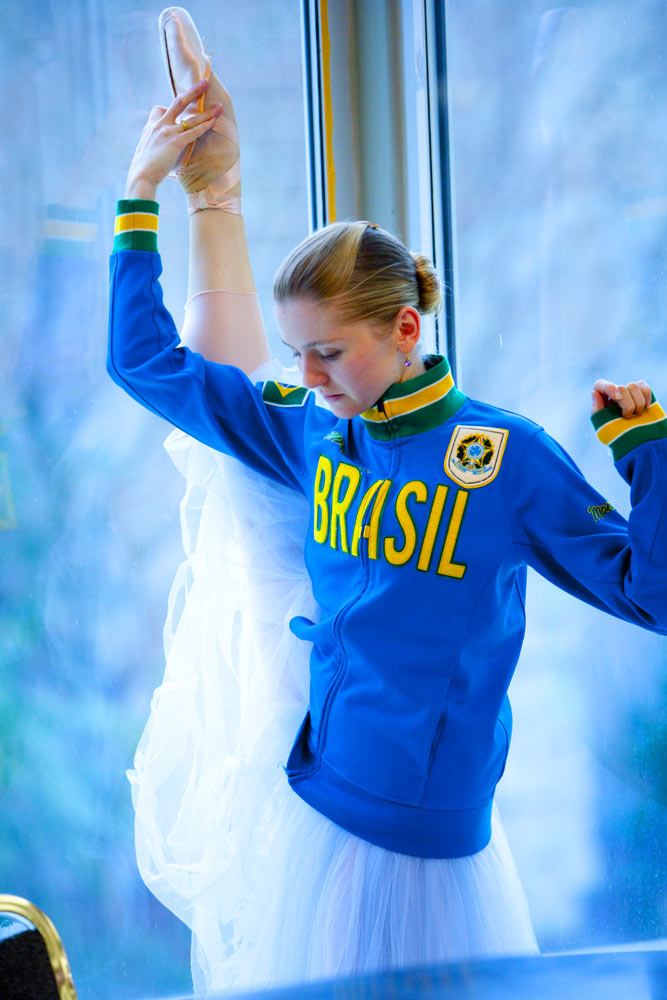
© Angela Sterling. (Click image for larger version)
A few days ago we spoke, via Skype. It was eight in the morning in Seattle, but Körbes did not seem the least put out by the interruption of her morning routine. Relaxed and quick to laugh, she told me about her preparations for the New York run.
www.pnb.org
www.nycitycenter.org
Details of PNB at City Center
So, how are you getting ready for the tour?
[She shows me a pair of pointe shoes and a sewing needle, then another pair, and another.] I’ve been getting up early. This is my life now.Is there a lot of buzz in the company?
I think people are really excited to take the whole company and the whole orchestra. Last summer we went to Italy, but it wasn’t the whole company. And it’s the fortieth anniversary [PNB was founded in 1972], so it feels like something special.
Will any of your family be able to come and see you dance?
My whole family is coming from Brazil. My mom, my dad, my sister, her husband, my aunt and my uncle, and two cousins. They’re going to be frozen! My aunt and uncle have only seen me dance once. Recently I went home and did a big show in my hometown, and it was the first time I met some of my cousins. So when the whole New York thing happened they said, we’ve always wanted to go to New York, so we’ll come! I haven’t seen my dad in a year and a half.
Where did you grow up, and how did you get into ballet?
My family is from Porto Alegre. Actually, we live in São Leopoldo which is thirty minutes away from Porto Alegre. That’s where I grew up. It’s one of those stories. There were two girls in the house, we were really young and full of energy. My mom and dad are both singers. They sang in a chorus – my dad has thirteen siblings, and they all sang. My mom and dad were very artistic, always listening to music. So when my sister and I were born, my mom put us in ballet. It was ballet and swimming and this and that and I hated everything but ballet.
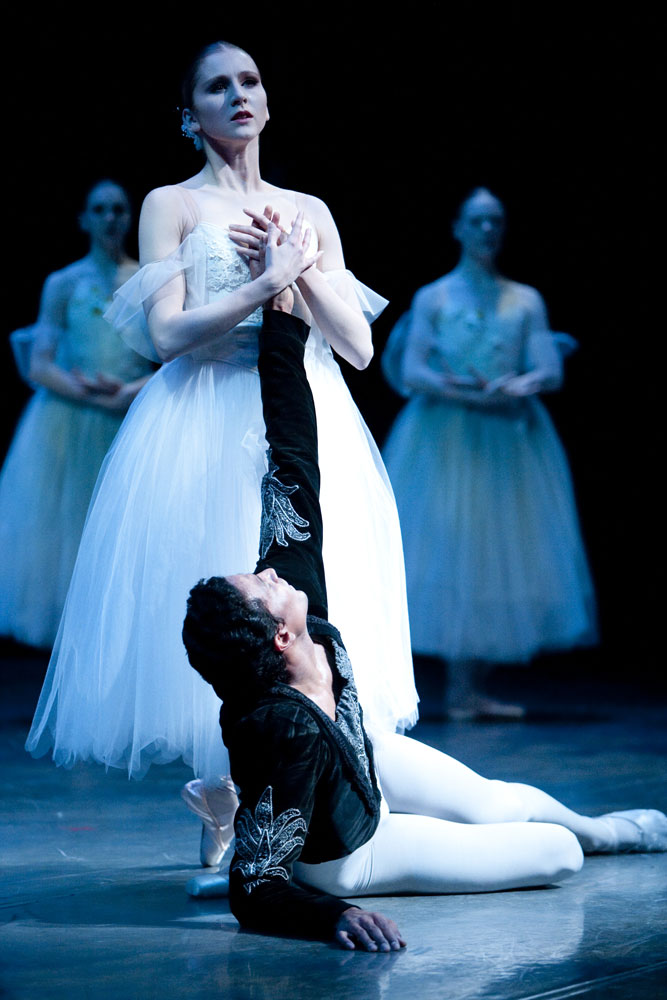
© Angela Sterling. (Click image for larger version)
What do you think it was that drew you to it?
My family loves classical music and when my mom was pregnant they would sit there and listen to classical music and I would kick, so I think it’s the music. Every Sunday my dad would blast music at six in the morning and I loved it. I would get up and dance.
Does your sister dance as well?
She did, until she got her first pair of pointe shoes. She was very smart (laughs). She was like: “why would you do this?”
Do you miss Brazil?
I moved to NY when I was turning fifteen. Now I’ve lived here sixteen years. It was very strange when the fifteen-year point hit, and now it’s tipping over to the other side. I miss my family.
Is Seattle a big ballet town?
Yeah. I think people here are really game for new things. We have a lot of different venues that do experimental and contemporary work and a lot of people come to the ballet and are moved. Even at matinees we always have a standing ovation. I feel like the community is really supportive, and I think it’s growing.
Does PNB dance Balanchine differently than New York City Ballet?
I think it will be very interesting for New Yorkers because Francia Russell [a founding artistic director at PNB, who danced at NYCB 1956-1961] stages a lot of the work the way she learned it from Mr. B. Of course, he changed the ballets for Suzanne [Farrell] and whomever he was coaching, but Francia really keeps the version she learned, and I think that’s very interesting.
Is there a difference in style?
Stepwise it’s different. When I first got here I would learn stuff from her and say, oh, that’s different… Every coach I’ve worked with over the years brings something different to Balanchine. PNB is fortunate because they’ve brought Violette [Verdy], Suzanne Farrell, Mimi Paul, Stephanie Saland, and others, so we’ve had a lot of people who have passed through. It’s so beautiful to see, because they’re all so passionate about what they want. Recently I revived the ballet Élégie at Vaill. I worked with Damian, and learned it mostly from watching tapes of Suzanne, but now I’m trying to figure out what Balanchine wanted.

© Angela Sterling. (Click image for larger version)
You’ve been dancing Apollo for such a long time… How has your interpretation changed?
It’s one of those ballets… The first time I did it I was fourteen. I learned it from watching the tape. It was such an experience for such a young kid. Then, once I got to NYCB I was able to properly learn it, but it was different having already done it. I don’t get to do it that often; actually I’ve done it more on gigs than in the company. So I dance it, and then I put it to rest, then I dance it, then I put it to rest… But it’s really nice to come back to. It’s a little bit different every time and it always takes me a while to get it how I want it. This time I pulled out my Suzanne videos and I’m trying to find my Goddess again.
What’s Terpsichore’s secret?
As Peter Boal says, the Muses have trained a lot of gods. I think she’s very wise and cool and looks down at Apollo like, “oh, he’s a baby,” but they do have a special connection. You know sometimes you meet someone and it’s just different. A special connection. I love Suzanne’s interpretation; she looks so cool, sort of like “ok little boy, here we go.”
How would you describe Jean-Christophe Maillot’s Roméo et Juliette?
It’s so abstract in a way, but very passionate. Throughout the ballet I think it’s a little bit more physical than other versions. There’s a lot of touching and kissing, for the whole cast. But it’s not so spelled out in terms of the sword fight and the big costumes. When we do the show, we walk in the studio and say, where did this bruise come from? You’re so emotionally involved that you don’t even really feel it when it happens.
How often have you performed it?
This will be only my second time. I feel that my Juliet has changed a lot since the last time. I understand the relationship between love and pain and losing things on a deeper level than last time. So it feels very easy to access those emotions when she sees Romeo and falls in love and that first kiss. It doesn’t feel so much like acting this time.
What is the set like?
There’s one set and it moves around. It’s very elegant. They’re set pieces, with curved walls. They’re actually really hard to make. It’s going to be challenging because City Center is so much smaller and the sets were built for our theatre. The other thing that’s going to be interesting is that in this ballet we use our breath a lot, because the steps don’t work unless you really do it, but we’re going to have to tone it down because otherwise the audience will be able to hear it.
Do you have a favorite partner?
I’ve been really lucky to have amazing partners in my career. Sometimes people don’t get along, but I’ve never had that experience. The people I’ve worked with the most are Karel Cruz – he’s really tall and Cuban, and he can turn for days – and then Batkhurel Bold, from Mongolia. I get to work with him a lot. And then Seth [Orza]. I’ve only known him for sixteen years! (Laughs.) We’re so comfortable together, so when we got to do Roméo et Juliette we were so happy. We wrote each other cards and it turns out we both bought similar cards and the cards said basically the same thing. I’ve known Seth and Sarah since we were in school…

© Angela Sterling. (Click image for larger version)
What was it like dancing PNB’s new Giselle, based on Stepanov notation and original French sources?
We were all kind of uptight because it was this new version and the process was slow, because Doug Fullington [a dance scholar who is PNB’s Education Programs Manager and Assistant to the Artistic Director] learned how to read notation and would sit with this book [Körbes holds her hands up in front of her face] and say things like, “I think it says arm up, and right leg behind.” [She laughs.] Oh my God, Doug. It took a long time, and because it took so long, and the whole company was together for so long, when we got onstage, everyone said they’d never seen the company so together and engaged. It felt like PNB was a unit. I had a really good time. I danced with Karel, and it couldn’t have been easier to do the part with him emotionally and physically. I’ve always wanted to dance Giselle. And I got to work with [ballet mistress] Elaine Bauer again, which I adore. She always works with me on full lengths. She worked with me on the death scene a lot.
Did it change you as a dancer?
You really feel like you’re one step closer to really experiencing the pure art of ballet. When you get to do Swan Lake and Giselle you gain a new understanding of the art. Every dancer should get the chance to do a Giselle; you just feel so complete.
How was it working with Alexei Ratmansky on his new Don Quixote?
Amazing, amazing. Have you ever seen a rehearsal with him? It’s mind-blowing to me. We’d do the first entrance with Kitri and he would stop us and correct Karel and me, and then proceed to correct everyone in the room. Detailed corrections. I would think, how did you see all that? I’ve never seen anyone be able to give, not repetitive corrections, but detailed… I think his criticism, the way he gives it, is very positive. You feel really seen by him. I felt understood by him. That was the most special thing.
How was his version different from the traditional Don Q?
It was hard! [laughs] Like in the gypsy dance, Kitri doesn’t usually do that much, but here we had to dance. In the coda [she hums it], before the pas de deux, we’re doing coupé jetés, and then you have to go and do the pas de deux. He made it a little more difficult, and it’s already a difficult role. He asks a lot, and he gets a lot.
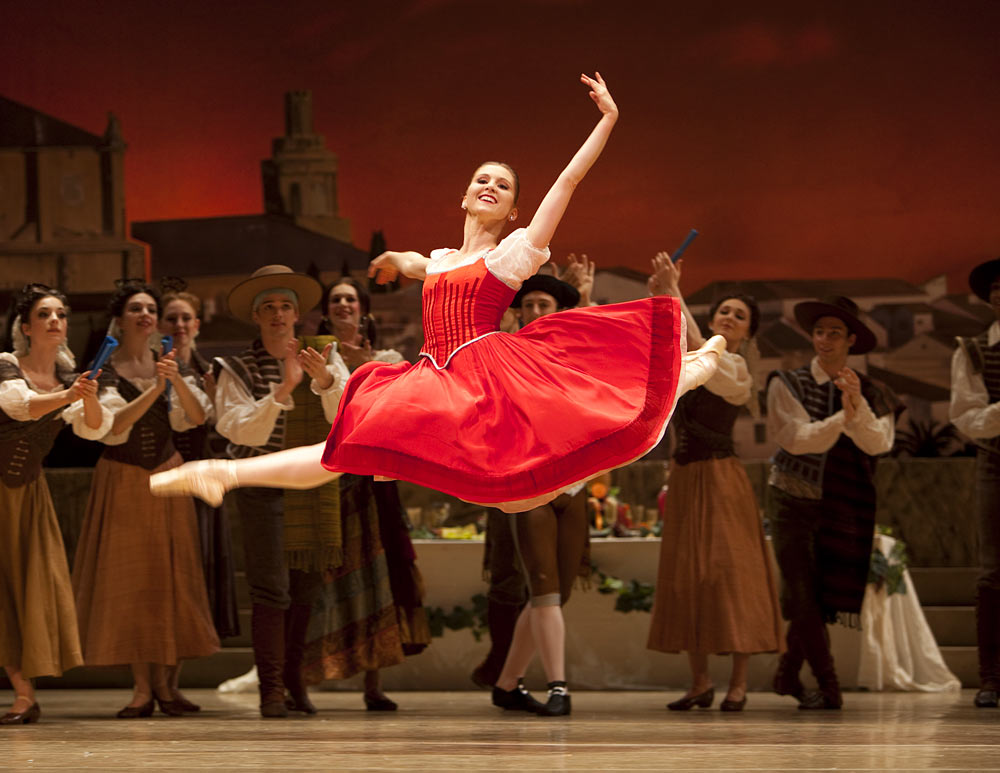
© Angela Sterling. (Click image for larger version)
Have you performed other Ratmansky ballets?
Yes, Concerto DSCH. Love it. I’m taking it on a guest thing to Dallas at the beginning of March…. Hopefully he can change the end for me [where the corps draws the two lovers apart]. The ending is quite sad. Even though Ratmansky doesn’t want it to be sad. He said to us, “it’s about wartime but what are you going to do, life goes on. I don’t want the pas de deux to be melodramatic, just a little sad, and then you separate, but with the hope that you’ll be able to get back together.” It’s so complex, so many layers.
Are there any up-and-coming dancers in the company we should look out for?
Yeah! Jerome Tisserand, but he’s not up and coming, he’s there already. We have a lot of young girls who are really good. There’s Leta [Biasucci], she was in “25 to Watch” in Dance Magazine, she’s adorable. She came from Oregon Ballet Theater. Then there’s Liz [Murphy], she’s doing one of the pas de trois in Agon, with Jonathan Porretta and Kylee Kitchens; she came from Ballet West and she’s beautiful.
Will you be able to catch any NYCB performances while you’re in town?
Usually when I fly into New York I always try to see a NYCB show, but this time my only night off is the fourteenth, it’s the only night I have with my family. Jean-Christophe Maillot is in town, so we’re going to be working from ten to six.
Do you have any special plans with your family?
I just want to hug them. It’s going to be my mom’s birthday so we’re going to celebrate that. I’m going to be working a lot, I’ll have four shows while I’m there. I know that they’re really excited. The first day I’m going to work with Damian the whole day, and then there’s the lecture demonstration. The second day, it’s Apollo all day long and then the show. Third day, I’ll be working with Jean-Christophe [Maillot] all day, and then it’s Romeo and Juliet, Romeo and Juliet, and then it’s over. It’s so much pressure, but I’m excited to dance and really excited to see my family.






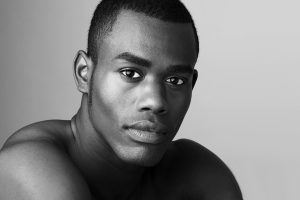








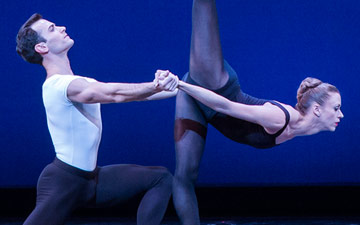

You must be logged in to post a comment.